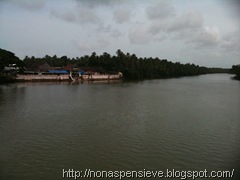Rama is the main deity in Triprayar Sreeramaswamy temple. If you are planning to visit all the four temples in one day, you should start your day from here. The temple opens at 3 am in the morning. During the month of Karkidakam, the locals start at 3 am in the morning in order to complete one circuit of all four temples by 9 am in the morning.
As evident from the name, this temple is located in Triprayar. The main entrance of the temple is from the river that flows through Triprayar. There are steps that lead up to the temple. The main offerings in this temple are vedi vazhipaadu and meenoottu. Vedi vazhipaadu in an overly simplistic way can be described as bursting of crackers. But the powder used and the vessel for this purpose produces more sound than crackers. The sound from this offering is used to awaken the deity. Meenootttu is translated as feeding of the fishes. The people throng on the steps that lead to the water and feed the fishes with rice grains. There is no fishing allowed in the water fearing the wrath of the deity.
View Larger Map
See below for the pictures of the temple. You can also see devotees on the steps leading to the temple feeding the fishes. Also, a video that show how vedi vazhipaadu is offered. The video gives you an idea what it is about and is not taken in the Sreeramaswamy temple.
Also see,
Tags: Travel,Nalambalam,Triprayar,Rama


Very nice, interesting and informative post. I was not aware of this temple. Next time when I will go to India shall definitely visit this place.
ReplyDeleteI have been here many times..its a beautiful temple
ReplyDeleteThat was interesting, and very well-explained. Temples and rituals fox me rather.
ReplyDelete@Babli - Be ready for the long queues when you vist the temple.
ReplyDelete@HeyIThinkThisWay - Thank you for dropping by. Thanks for commenting.
@Sucharita - I love the stories associated with the temples.